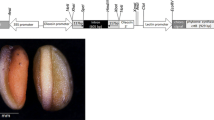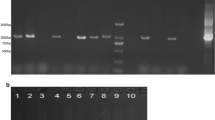Abstract
Hypercholesterolemia, a form of cardiovascular disease, is one of the leading causes of deaths worldwide. Lactostatin (Ile-Ile-Ala-Glu-Lys), derived from β-lactoglobulin in cow’s milk, is a bioactive peptide with hypocholesterolemic activity higher than sitosterol, a known anti-hypercholesterolemic drug. Here, we successfully developed a transgenic rice accumulating a much higher level of lactostatin by inserting 29 IIAEK sequences into the structurally flexible (nonconserved) regions of soybean seed storage protein, A1aB1b, and introducing it into LGC-1 (low glutelin content mutant 1) as host variety. A1aB1b containing 29 lactostatins was expressed in the endosperm of rice seed cells by using seed specific promoters and sorted into novel compartments distinct from normal PB-I (ER-derived protein body) and PB-II (protein storage vacuoles). Transgenic rice seeds accumulated approximately 2 mg of lactostatins/g of dry seeds, which is relatively high compared with previous reports. Our findings suggest that the introduction of a high copy number of bioactive peptide into seed storage proteins as carrier is one of the effective means in producing higher amounts of bioactive peptides in rice.






Similar content being viewed by others
References
Adachi M, Takenaka Y, Gidamis AB, Mikami B, Utsumi S (2001) Crystal structure of soybean proglycinin A1aB1b homotrimer. J Mol Biol 305:291–305
Bridget BK, Fuster V (2010) Promoting cardiovascular health in the developing world: a critical challenge to achieve global health. National Academies Press, Washington, DC
Chobanian AV, Bakris GL, Black HR, Cushman WC, Green LA, Izzo JL Jr, National Heart, Lung and Blood Institute Joint National Committee on Prevention, Detection, Evaluation and Treatment of High Blood Pressure, National High Blood Pressure Education Program Coordinating Committee et al (2003) The seventh report of the Joint National Committee on Prevention, Detection, Evaluation, and Treatment of High Blood Pressure: the JNC 7 report. J Am Med Assoc 289:2560–2572
Gaziano TA, Bitton A, Anand S, Abrahams-Gessel S, Murphy A (2010) Growing epidemic of coronary heart disease in low- and middle-income countries. Curr Probl Cardiol 35:72–115
Goto F, Yoshihara T, Shigemoto N, Toki S, Takaiwa F (1999) Iron fortification of rice seed by the soybean ferritin gene. Nat Biotechnol 17:282–286
Hood EE, Gelvin SB, Melchers L, Hoekema A (1993) New agrobacterium helper plasmids for gene transfer to plants. Transgenic Res 2:208–218
Katsube T, Kurisaka N, Ogawa M, Maruyama N, Ohtsuka R, Utsumi S, Takaiwa F (1999) Accumulation of soybean glycinin and its assembly with the glutelins in rice. Plant Physiol 120:1063–1074
Kuroda M, Kimizu M, Mikami C (2010) A simple set of plasmids for the production of transgenic plants. Biosci Biotechnol Biochem 74:2348–2351
Kusaba M, Miyahara K, Iida S, Fukuoka H, Takano T, Sassa H, Nishimura M, Nishio T (2003) Low glutelin content1: a dominant mutation that suppresses the glutelin multigene family via RNA silencing in rice. Plant Cell 15:1455–1467
Laemmli UK (1970) Cleavage of structural proteins during the assembly of the head of bacteriophage T4. Nature 227:680–685
Maniatis T, Fritsch EF, Sambrook J (1982) Molecular cloning: a laboratory manual. Cold Spring Harbor Laboratory, Cold Spring Harbor
Maruyama N, Mikami B, Utsumi S (2011) The development of transgenic crops to improve human health by advanced utilization of seed storage proteins. Biosci Biotechnol Biochem 75:823–828
Matoba N, Doyama N, Yamada Y, Maruyama N, Utsumi S, Yoshikawa M (2001) Design and production of genetically modified soybean protein with anti-hypertensive activity by incorporating potent analogue of ovokinin (2–7). FEBS Lett 497:50–54
Morikawa K, Kondo I, Kanamaru Y, Nagaoka S (2007) A novel regulatory pathway for cholesterol degradation via lactostatin. Biochem Biophys Res Commun 352:697–702
Murashige T, Skoog F (1962) A revised medium for rapid growth and bio assays with tobacco tissue culture. Physiol Plantarum 15:473–497
Osborne TB (1907) The proteins of the wheat kernel. Carnegie Institution of Washington, Publ No. 84, 119 pp
Prak K, Utsumi S (2009) Production of a bioactive peptide (IIAEK) in Escherichia coli using soybean proglycinin A1ab1b as a carrier. J Agric Food Chem 57:3792–3799
Prak K, Maruyama Y, Maruyama N, Utsumi S (2005) Design of genetically modified soybean proglycinin A1aB1b with multiple copies of bioactive peptide sequences. Peptides 27:1179–1186
Prak K, Maruyama Y, Maruyama N, Utsumi S (2006) Design of genetically modified soybean proglycinin A1aB1b with multiple copies of bioactive peptide sequences. Peptides 27:1179–1186
Qu LQ, Takaiwa F (2004) Evaluation of tissue specificity and expression strength of rice seed component gene promoters in transgenic rice. Plant Biotech J 2:113–125
Saito H, Shigemitsu T, Yamasaki R, Sasou A, Goto F, Kishida K, Kuroda M, Tanaka K, Morita S, Satoh S, Masumura T (2012) Formation mechanism of the internal structure of type I protein bodies in rice endosperm: relationship between the localization of prolamin species and the expression of individual genes. Plant J 70:1043–1055
Tada Y, Utsumi S, Takaiwa F (2003) Foreign gene products can be enhanced by introduction into low storage protein mutants. Plant Biotech J 1:411–422
Takaiwa F (2005) Health-promoting transgenic rice suppressing life-related disease and type-I allergy. In: Toriyama K, Heong KL, Hardy B (eds) Rice is life: scientific perspectives for the 21st century, proceedings of the world rice research conference, Tsukuba, Japan, pp 102–105
Takaiwa F, Sakuta C, Choi SK, Tada Y, Motoyama T, Utsumi S (2008) Co-expression of soybean glycinins A1aB1b and A3B4 enhances their accumulation levels in transgenic rice seed. Plant Cell Physiol 49:1589–1599
Tandang-Silvas MR, Tecson-Mendoza EM, Mikami B, Utsumi S, Maruyama N (2011) Molecular design of seed storage proteins for enhanced food physicochemical properties. Annu Rev Food Sci Technol 2:59–73
Wakasa Y, Yasuda H, Takaiwa F (2006) High accumulation of bioactive peptide in transgenic rice seeds by expression of introduced multiple genes. Plant Biotechnol J 4:499–510
Wakasa Y, Tamakoshi C, Ohno T, Hirose S, Goto T, Nagaoka S, Takaiwa F (2011) The hypocholesterolemic activity of transgenic rice seed accumulating lactostatin, a bioactive peptide derived from bovine milk β-lactoglobulin. J Agric Food Chem 59:3845–3850
Yang L, Wakasa Y, Takaiwa F (2008) Biopharming to increase bioactive peptides in rice seed. J AOAC Int 91:957–964
Acknowledgments
We thank DASH (Development and Assessment of Sustainable Humanosphere) system and Prof. Kazufumi Yazaki of Kyoto University for supporting the development of the transgenic crop. We also thank Prof. Reiko Urade (Kyoto University) for the warm encouragement and Ms. M. Sawada and Ms E. Okuda for technical assistance. This research was supported by the research grant, “Genomics and Agricultural Innovation, GMC0008” from the Ministry of Agriculture, Forestry and Fisheries of Japan to M. Kuroda, S. Nagaoka, F. Takaiwa, S. Utsumi and N. Maruyama, and the Asahi Glass Foundation to N Maruyama and S Utsumi.
Author information
Authors and Affiliations
Corresponding author
Additional information
Cerrone Cabanos, Atsushi Ekyo, and Yoshiki Amari contributed equally to this work.
Rights and permissions
About this article
Cite this article
Cabanos, C., Ekyo, A., Amari, Y. et al. High-level production of lactostatin, a hypocholesterolemic peptide, in transgenic rice using soybean A1aB1b as carrier. Transgenic Res 22, 621–629 (2013). https://doi.org/10.1007/s11248-012-9672-5
Received:
Accepted:
Published:
Issue Date:
DOI: https://doi.org/10.1007/s11248-012-9672-5




